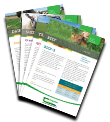
Dairy Newsletter – February 2025
Dairy Newsletter – February 2025 10 February 2025 Type Newsletter Download Publication (PDF) In this month’s edition: Top five tips for February Achieve at least one grazing every day – spring grass is the best-quality forage available on farm. Consider once-a-day (OAD) milking in February – for some farms the opportunity is there to reduce […]
10 February 2025
Type Newsletter
By

Dairy Newsletter – February 2025
10 February 2025
Type Newsletter
Type Newsletter
Download Publication (PDF)
In this month’s edition:
- Top five tips for February
- Achieve at least one grazing every day – spring grass is the best-quality forage available on farm.
- Consider once-a-day (OAD) milking in February – for some farms the opportunity is there to reduce the workload by milking OAD for the first couple of weeks of the calving season.
- Include slurry as part of your spring fertiliser plans – slurry contains six units of nitrogen (N), five units of phosphorus (P), and 30 units potassium (K) per 1,000 gallons.
- Test every batch of colostrum – you can quickly and easily measure colostrum quality by using a Brix refractometer – a reading of 22% or more indicates good quality colostrum.
- Run a fresh cow group in February – calving is a hectic time on dairy farms.
- Take your grazing opportunities
It’s that time of year again when the debate on the merits of early grazing kicks off. Depending on the conversation, it is somewhere between an essential practice and a fool’s errand to have cows out in February. - Make colostrum testing a habit
Every article on calf health begins with feeding the right colostrum at the right time and quantity. The colostrum 1-2-3 rule helps us quantify what right actually means: feed the first milk the cow produces, within two hours of birth and feed at least three litres. Get in the habit of testing colostrum using a refractometer. - Health & Safety – Safety at calving and slurry spreading
With slurry, evacuate all animals and ventilate before you agitate. Select a breezy day and open all doors and outlets to provide a draught. Keep people away from the shed and agitation point for at least 40 minutes after starting. Keep the tank opening secure at all times. Beware of gas in buildings that are linked by tanks or drainage channels.
Keep safe during calving. Use calving gates and pens. Keep a physical barrier between you and a calving cow at all times.
